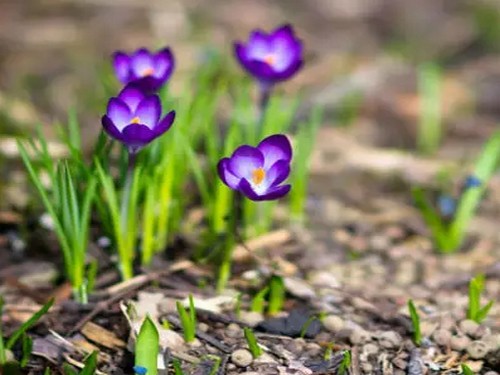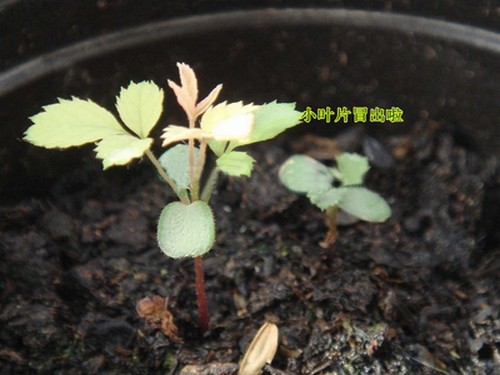Propagation method of saffron (saffron)
Saffron, also known as saffron, saffron, is a kind of perennial flower of saffron genus of Iridaceae, and it is also a common spice, perennial herb. Saffron is a bulbous plant and is a rare cold-tolerant variety. The most commonly used method of reproduction is to divide balls. Saffron is divided before flowering from August to September, and many copies of saffron can be seen when it blossoms. Let's take a look at the specific methods of reproduction.

Bulbous reproduction of saffron:
Break-up time:
The growing period of saffron is in winter and spring, and there are two varieties: autumn flowering and spring ring opening, and the bulbs are usually divided from August to September. The earlier the ball is divided, the more beneficial it is to a strong seedling.
Select the seed ball:
The residual flowers should be picked immediately after blooming in spring to avoid nutrient consumption, and the compound fertilizer solution dominated by phosphorus and potassium should be applied once or twice to promote the growth and firmness of bulb roots and continue to maintain normally. In summer, the aboveground parts are withered and yellow, and the bulbs are taken out and dried and stored.
Save the seed ball:
Cut off the residual leaves at the top, remove the remains of the mother bulb, then move them into the room, grade them according to size, and put them on the indoor plaque frame. There is no need to bury the soil, the bulb bud mouth up, flat in the plaque, there is a slight gap between the bulbs.
Indoor pot ramet:
In autumn, those with bulbs can split according to the shape of the bulbs. Break it open directly with your hands and plant it in a pot.
Maintenance after dividing the ball:
After dividing the ball, appropriately increase the indoor air humidity and keep the soil moist. Promote seed germination.
After mid-August, when the temperature drops, there is generally no need to take cooling measures. The suitable temperature of saffron is 15: 18 ℃. Controlling the indoor temperature after dividing the ball can promote flowering.
Sowing and breeding of saffron:
Saffron is not easy to seed and needs artificial pollination to obtain seeds. So if you want to use the method of sowing and reproduction, you can buy seeds from the florist.
In the spring and autumn season, sow the seeds directly in the basin, with an interval of 5 to 10 centimeters between the seeds. It is better to be rare. Because the plant grows bulbs, the pot can not be changed to loosen the soil within 2 years.
It takes 3 to 4 years from seed sowing to plant flowering. During this period, you can properly water and fertilize.
Saffron can be propagated by ball division and sowing, but mainly by ball division.
Divide the ball to reproduce:
It is generally carried out from August to September, the mature corm has several main and lateral buds, and after flowering, it expands from the base of the leaf clump to form a new corm. After the aboveground part withered in summer, the corm was dug out, graded, dried and stored. The early planting time is beneficial to the formation of strong seedlings.
Each mature bulb has several main buds and lateral buds. When planting, big balls and small balls of more than 8 grams should be planted separately. Bulbs weighing less than 8 grams can not blossom in the same year and need to be cultivated for another year. The pot should choose the spring flower species with bulb weight of about 20 grams in October, and the flowerpots with an inner diameter of 15 centimeters can plant 5 to 6 balls in each pot. After planting, put it outside for maintenance. It takes root after about two weeks and moves to a place with sufficient indoor light and fresh and moist air. New Year's Day can blossom before and after.
The residual flowers should be picked immediately after flowering to avoid nutrient consumption, and the compound fertilizer solution dominated by phosphorus and potassium should be applied once or twice to promote the growth and firmness of bulbs. Continue to maintain normally, until the aboveground part turns yellow in summer, take out the bulb and store it after drying. Saffron can also be water-raised and ornamental, in the same way as daffodils.
To sow and reproduce:
As saffron is not easy to seed, it needs artificial pollination to get seeds. After the seeds are ripe, the seeds will be sown in the open field seedbed or pot with harvest. The seed sowing density should not be too high, and it is better to be sparse, because the plant needs to grow balls and generally cannot dig within 2 years. It often takes 3-4 years from seed sowing to plant flowering.
Time: 2019-06-11 Click:
- Prev

Propagation methods of Cymbidium grandiflora
Cymbidium can generally be propagated by ramet method, and it is a suitable time for ramet when new buds begin to sprout in spring. The new plant after ramet should have more than 3 pseudobulbs. After cutting and waiting for the wound to dry, the normal plant can split once every 3 years. Cutters should be disinfected when ramet to avoid virus infection.
- Next

Rose seed sowing method
Growing roses from seeds can be challenging because most of the seeds you collect tend not to germinate, no matter how hard you try. Fortunately, most rose plants produce a large number of seeds, so there is usually no need to achieve a high success rate.
Related
- Fuxing push coffee new agricultural production and marketing class: lack of small-scale processing plants
- Jujube rice field leisure farm deep ploughing Yilan for five years to create a space for organic food and play
- Nongyu Farm-A trial of organic papaya for brave women with advanced technology
- Four points for attention in the prevention and control of diseases and insect pests of edible fungi
- How to add nutrient solution to Edible Fungi
- Is there any good way to control edible fungus mites?
- Open Inoculation Technology of Edible Fungi
- Is there any clever way to use fertilizer for edible fungus in winter?
- What agents are used to kill the pathogens of edible fungi in the mushroom shed?
- Rapid drying of Edible Fungi

